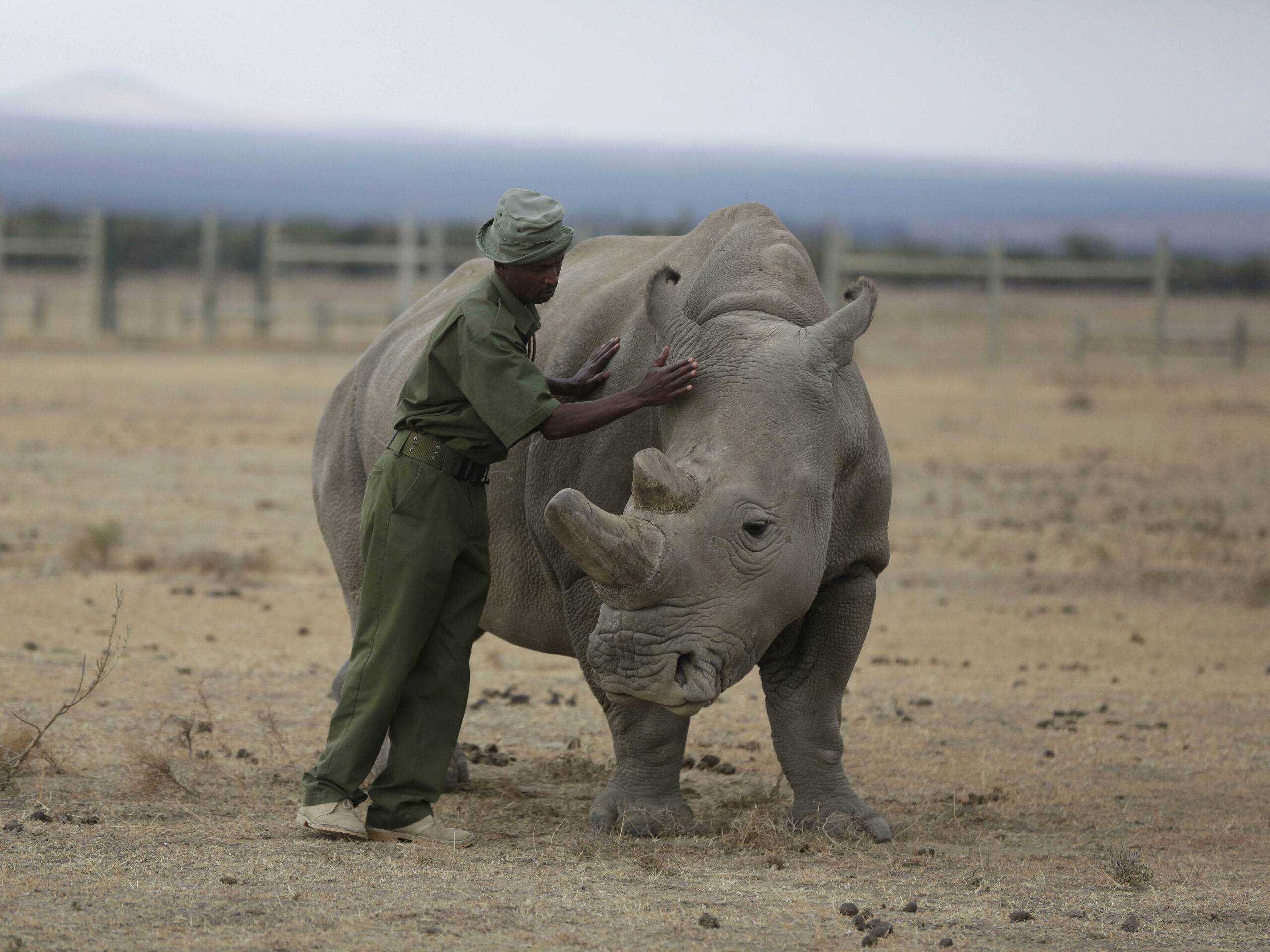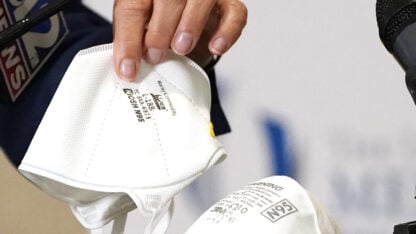Scientists Hope Lab-Grown Embryos Can Save Rhino Species From Extinction

Keeper Zachariah Mutai attends in March to Fatu, one of only two female northern white rhinos left in the world, in the pen where she is kept for observation, at the Ol Pejeta Conservancy in Laikipia county in Kenya. Scientists have successfully grown hybrid white rhino embryos in the lab, stoking hopes that a purebred … Continued
Rhino embryos created in a lab are raising hopes that high-tech assisted reproduction may help save the northern white rhino, the most endangered mammal in the world.
Only two of these rhinos are still alive, both females living in a sanctuary in Kenya and protected around the clock by armed guards.
The last male, a rhino named Sudan, died in March. But before the males died off, wildlife experts collected and froze sperm. Now, in the journal Nature Communications, scientists say they successfully have used this stored sperm to fertilize eggs taken from a closely related subspecies, the southern white rhinoceros.
The resulting hybrid embryos started to develop in a lab dish. Two were frozen for later implantation into a surrogate rhino, although the researchers note in their paper that “the embryo transfer procedure has yet to be developed and validated in rhinoceroses.”
Still, the researchers are hopeful that once they get this working with hybrid embryos, they can use the same techniques to produce pure northern white rhino embryos.
To make those, they’ll need eggs from the two remaining northern white rhinos. Jan Stejskal, of the Dvur Kralove Zoo in the Czech Republic — where rhinos Najin and Fatu were born — says the team has requested permission to obtain the eggs, “but it’s not granted yet.” Still, he hopes the research team can go to Kenya to collect them by the end of the year.
“Our goal is that we have, in three years, the first northern white rhino calf born,” says Thomas Hildebrandt, of the Leibniz Institute for Zoo and Wildlife Research in Berlin.
While this kind of assisted reproduction is used for other large mammals, including horses and cows, this is the first time lab-grown rhino embryos have reached the point they could be transferred into a uterus.
“That’s a big deal. That’s a big jump in rhino assisted-reproductive technology,” says Terri Roth, director of the Center for Conservation and Research of Endangered Wildlife at the Cincinnati Zoo & Botanical Garden. “In the past, we’ve really struggled to just produce two-cell embryos. So this is taking it way beyond that.”
But Roth, who wasn’t involved in the study, cautions that going from an embryo in the lab to an actual baby rhino is no small feat. “There are many, many steps from the petri dish to the live calf on the ground,” she says.
Because of the uncertainties, the scientists are pursuing several different strategies. Besides trying to produce pure northern white rhinos, they also plan to transfer hybrid embryos into surrogates. Hybrids of southern and northern white rhinos could help conservationists, if they ever try to introduce white rhinos back to their northern range.
It also could be possible to use generations of inbreeding to dilute out the southern white rhino genes and get to something close to a pure northern white rhino—although that would require a small herd of the hybrids.
“Will we ever get back to having a pure northern white rhino again? I think the odds are low,” says Roth. “But that doesn’t mean those genes aren’t important.”
Besides working with sperm and eggs collected from northern white rhinos, the scientists have a longer-term goal of making sperm and eggs to order in the lab, by manipulating stored skin cells taken from the animals.
“That might take maybe a decade,” says Hildebrandt. Already though, using some rhino embryos, the team has established that they can make an embryonic stem cell line, a step that’s useful in that process.
Roth calls that whole plan “highly speculative,” and thinks the most important lesson here is that it’s a mistake to get to a point where advanced technology is the only remaining option to save a species.
The northern white rhino isn’t the only rhino that’s in trouble, after all: Of the five living rhino species, three are listed as critically endangered because of poaching and habitat loss. Fewer than a hundred Sumatran rhinos, for example, are believed to exist today.
“We could still bring them back,” says Roth, “but if we lose another 90 of those animals and we’re down to 10, then we’re going to lose that one too.”
9(MDAxODM0MDY4MDEyMTY4NDA3MzI3YjkzMw004))








